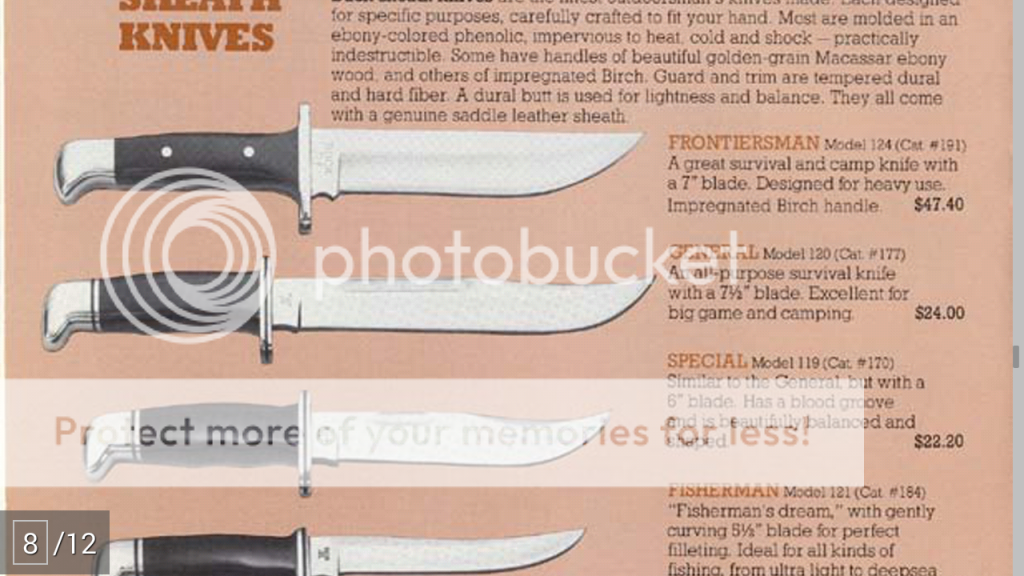- Joined
- Jul 24, 2014
- Messages
- 328
I mentioned elsewhere that I bought the 119, 120 and 124 sometime around 1980, used them for a while and then preferred other knives because of the sheaths. Recently I've been concentrating upon the 119 as probably the knife I'll use most often on hikes. I do check eBay for the 120 & 124 from time to time . . . just because.
And bought a 124 in the "Buck/124/USA" time frame with cocobolo handles -- or redwood but I think cocobolo. I notice that while Buck resumed making the 124 they haven't resumed the cocobolo variation -- at least I haven't seen it at my favorite store; so I either made an offer or placed a bid -- anyway I got it for a reasonable price, around $30 less than a new one with a micarta handle. The pommel isn't any more dinged up than my black 124 in the Buck/124/USA time frame but there are other differences, differences I didn't expect.
The first is the handle shape. One of the things I didn't like about my black (I don't recall whether the handle material is micarta or something else) handle is that it is overly square. The cocobola 124 has a more rounded handle and is much more comfortable in the hand. It doesn't look as though it has been modified. So perhaps my black is an earlier Buck/124/USA and the Cocobolo is later and more rounded due to complaints. I haven't bought a modern 124 & so don't know if that is a valid conjecture. I seem to recall someone else complaining about the 124's square handle but I don't recall the date of his knife.
Another difference is blade shape. My black 124 has, and I can't recall the proper term, more of an outward curve to the blade. The Cocobola is much more straight.
There is a radical difference in the edges. The black has a rounded edge, making it IMO harder to hold an edge. The Cocobola has a flatter and better (IMO) edge.
The black is also rounded where it meets the spine of the knife (can't recall the term for this either). The Cocobola has a pronounced angle at this spot.
The cocobola is a wee bit more beat up than my old black, but I like it a lot better. If I'm going to take a 124 on a hike in the future it will be the former knife and not the latter.
Lawrence
And bought a 124 in the "Buck/124/USA" time frame with cocobolo handles -- or redwood but I think cocobolo. I notice that while Buck resumed making the 124 they haven't resumed the cocobolo variation -- at least I haven't seen it at my favorite store; so I either made an offer or placed a bid -- anyway I got it for a reasonable price, around $30 less than a new one with a micarta handle. The pommel isn't any more dinged up than my black 124 in the Buck/124/USA time frame but there are other differences, differences I didn't expect.
The first is the handle shape. One of the things I didn't like about my black (I don't recall whether the handle material is micarta or something else) handle is that it is overly square. The cocobola 124 has a more rounded handle and is much more comfortable in the hand. It doesn't look as though it has been modified. So perhaps my black is an earlier Buck/124/USA and the Cocobolo is later and more rounded due to complaints. I haven't bought a modern 124 & so don't know if that is a valid conjecture. I seem to recall someone else complaining about the 124's square handle but I don't recall the date of his knife.
Another difference is blade shape. My black 124 has, and I can't recall the proper term, more of an outward curve to the blade. The Cocobola is much more straight.
There is a radical difference in the edges. The black has a rounded edge, making it IMO harder to hold an edge. The Cocobola has a flatter and better (IMO) edge.
The black is also rounded where it meets the spine of the knife (can't recall the term for this either). The Cocobola has a pronounced angle at this spot.
The cocobola is a wee bit more beat up than my old black, but I like it a lot better. If I'm going to take a 124 on a hike in the future it will be the former knife and not the latter.
Lawrence



